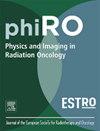Multicentre prospective risk analysis of a fully automated radiotherapy workflow
IF 3.3
Q2 ONCOLOGY
引用次数: 0
Abstract
Background and Purpose
Fully automated workflows (FAWs) for radiotherapy treatment preparation are feasible, but remain underutilized in clinical settings. A multicentre prospective risk analysis was conducted to support centres in managing FAW-related risks and to identify workflow steps needing improvement.
Material and Methods
Eight European radiotherapy centres performed a failure mode and effect analysis (FMEA) on a hypothetical FAW, with a manual review step at the end. Centres assessed occurrence, severity and detectability of provided, or newly added, failure modes to obtain a risk score. Quantitative analysis was performed on curated data, while qualitative analysis summarized free text comments.
Results
Manual review and auto-segmentation were identified as the highest-risk steps and the highest scoring failure modes were associated with inadequate manual review (high detectability and severity score), incorrect (i.e. outside of intended use) application of the FAW (high severity score) and protocol violations during patient preparation (high occurrence score). The qualitative analysis highlighted amongst others the risk of deviation from protocol and the difficulty for manual review to recognize automation errors. The risk associated with the technical parts of the workflow was considered low.
Conclusions
The FMEA analysis highlighted that points where people interact with the FAW were considered higher risk than lack of trust in the FAW itself. Major concerns were the ability of people to correctly judge output in case of low generalizability and increasing skill degradation. Consequently, educational programs and interpretative tools are essential prerequisites for widespread clinical application of FAWs.
全自动放疗工作流程的多中心前瞻性风险分析
背景和有目的的自动化工作流程(FAWs)用于放射治疗准备是可行的,但在临床环境中仍未得到充分利用。进行了多中心前瞻性风险分析,以支持各中心管理与fai有关的风险,并确定需要改进的工作流程步骤。材料和方法8个欧洲放疗中心对假设的FAW进行了失效模式和效应分析(FMEA),最后进行了人工审查步骤。中心评估提供的或新增加的故障模式的发生、严重程度和可检测性,以获得风险评分。定量分析是对整理好的数据进行的,而定性分析是对自由文本评论进行的总结。结果人工审查和自动分割被认为是风险最高的步骤,得分最高的失败模式与人工审查不充分(高可检测性和严重程度评分)、FAW应用不正确(即超出预期用途)(高严重程度评分)和患者准备期间违反协议(高发生率评分)相关。定性分析特别强调了偏离协议的风险以及人工审查识别自动化错误的难度。与工作流的技术部分相关的风险被认为很低。FMEA分析强调,人们与FAW互动的点被认为比对FAW本身缺乏信任的风险更高。主要关注的是人们在低通用性和技能退化的情况下正确判断输出的能力。因此,教育计划和解释性工具是FAWs广泛临床应用的必要先决条件。
本文章由计算机程序翻译,如有差异,请以英文原文为准。
求助全文
约1分钟内获得全文
求助全文
来源期刊

Physics and Imaging in Radiation Oncology
Physics and Astronomy-Radiation
CiteScore
5.30
自引率
18.90%
发文量
93
审稿时长
6 weeks
 求助内容:
求助内容: 应助结果提醒方式:
应助结果提醒方式:


